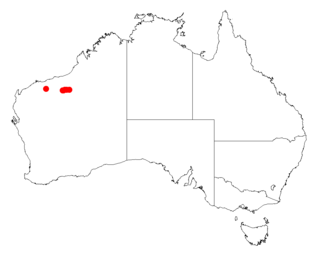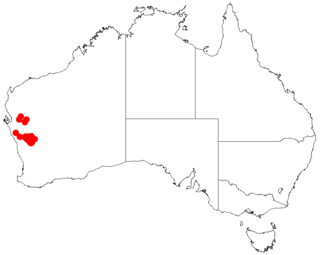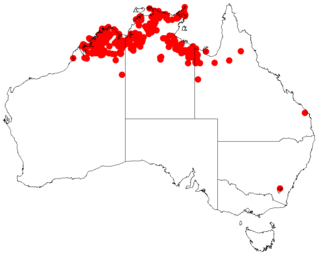
Acacia aptaneura, commonly known as slender mulga, is a shrub belonging to the genus Acacia and the subgenus Juliflorae. It is native to central and western parts of Australia.

Acacia areolata is a shrub belonging to the genus Acacia and the subgenus Juliflorae that is endemic to north western Australia.

Acacia caesaneura, commonly known as western blue mulga, is a shrub or tree belonging to the genus Acacia and the subgenus Juliflorae that is endemic to western Australia.

Acacia calligera is a bush belonging to the genus Acacia and the subgenus Juliflorae across northern Australia.

Acacia fecunda, commonly known as Mosquito Creek wattle, is a shrub belonging to the genus Acacia and the subgenus Juliflorae that is endemic to north western Australia.
Acacia filipes is a shrub belonging to the genus Acacia and the subgenus Juliflorae that is endemic to a small area in northern Australia.

Acacia gonoclada, also known as ganambureng, is a tree or shrub belonging to the genus Acacia and the subgenus Juliflorae that is endemic to northern Australia.

Acacia incognita, also known as false sugar brother, is a shrub or tree belonging to the genus Acacia and the subgenus Juliflorae that is endemic to Western Australia.

Acacia mulganeura, commonly known as milky mulga and hilltop mulga, is a tree or shrub belonging to the genus Acacia and the subgenus Juliflorae that is endemic to arid parts of central and western Australia.

Acacia oncinocarpa is a shrub or tree belonging to the genus Acacia and the subgenus Juliflorae that is endemic to northern Australia.

Acacia plectocarpa is a tree or shrub belonging to the genus Acacia and the subgenus Juliflorae that is endemism to north western Australia.

Acacia stigmatophylla, also known as djulurd, is a shrub belonging to the genus Acacia and the subgenus Juliflorae the is endemic to northern parts of Western Australia.

Acacia symonii, also known commonly as Symon's wattle, is a tree or shrub belonging to the genus Acacia and the subgenus Juliflorae that is endemic to parts of arid central Australia.

Acacia dictyophleba, also known as the sandhill wattle, waxy wattle and feather veined wattle, is a shrub belonging to the genus Acacia and the subgenus Phyllodineae. The Nyangumarta peoples know the plant as Langkur or Lungkun and the Thalanyji know it as Jabandi.

Acacia abbreviata is a shrub belonging to the genus Acacia and the subgenus Juliflorae. It is endemic to arid parts of northern Australia

Acacia gracilifolia, commonly known as graceful wattle, is a shrub belonging to the genus Acacia and the subgenus Plurinerves native to a small area of central southern Australia.

Acacia armitii is a shrub belonging to the genus Acacia and the subgenus Juliflorae that is native to north eastern Australia. It is considered as near threatened in Queensland.

Acacia caroleae, also known as Carol's wattle or narrow leaf currawong, is a shrub belonging to the genus Acacia and the subgenus Juliflorae that is native to north eastern Australia.

Acacia disparrima, also commonly known as southern salwood, is a shrub or tree belonging to the genus Acacia and the subgenus Juliflorae that is native to north eastern Australia.

Acacia torulosa is a shrub or tree belonging to the genus Acacia and the subgenus Juliflorae that is native to north eastern Australia.



















